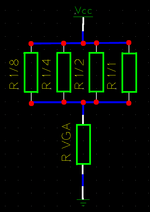Minimig Video d/a resistor ladder
Jump to navigation
Jump to search
Contents
Electrical model
Equations
- Defining constants:
- U_vga = 0.7 V
- R_vga = 75 Ω
- U_vcc = 3.3 V
- Total resistance = 1/(1/4000+1/2000+1/1000+1/560)+75 = 357.8282.. Ω
- Common current through resistor ladder plus vga impedance (75Ω) = 3.3V / 357.8282.. = 0.009222 A
- Current * VGA impedance = 0.6917 V (specification says max 0.7V p-p)
- Output voltage = 75 * (3.3/(1/(1/4000+1/2000+1/1000+1/560)+75)) = 0.6917 V
- Simplification:
- U = (75*3.3)/(1/(1/4000+1/2000+1/1000+1/560)+75) = 0.6917V
- Base resistor value = (1/8+1/4+1/2+1/1)/(1/((R_vga*U_vcc)/U_vga-R_vga)) = 522.3214Ω
- Deviation summary:
- 0523/523 = 1.0000
- 1050/523 = 2.0076
- 2100/523 = 4.0153
- 4220/523 = 8.0688
- As can be seen no more than 1% is useful with digikey resistors. Resistor combinations will add tolerances and use valuable pcb space.
- Maximum output voltage if VGA impedance is 75Ω is: (75*3.3)/(1/(1/4220+1/2100+1/1050+1/523)+75) = 0.6981 V
Useful links
- Wikipedia: Resistor
- Wikipedia: Preferred number
- Digikey: Resistors
- Wikipedia: Thin vs Thickfilm resistor
- In essence Thin = More expensive, but without nasty temperature coefficient.
Digikey ordering:
| Value | Order number (digikey.com) |
|---|---|
| 523 | RR12P523DCT-ND |
| 1.05K | RG20P1.05KBCT-ND |
| 2.1K | RR12P2.1KDCT-ND |
| 4.22K | RR12P4.22KBCT-ND |
Value-vs-Amplitude Originaly
The original 4000Ω 2000Ω 1000Ω 560Ω resistors, Gives this curve for the desired vs actual amplitude:
Note the dent in the middle of the curve!
| Value | Amplitude [V] |
|---|---|
| 0 | 0.000002 |
| 1 | 0.060736 |
| 2 | 0.119277 |
| 3 | 0.175740 |
| 4 | 0.230233 |
| 5 | 0.282857 |
| 6 | 0.333708 |
| 7 | 0.382873 |
| 8 | 0.389764 |
| 9 | 0.437103 |
| 10 | 0.482927 |
| 11 | 0.527307 |
| 12 | 0.570310 |
| 13 | 0.612000 |
| 14 | 0.652436 |
| 15 | 0.691673 |
Value-vs-Amplitude Modified
The modification with 4220Ω 2100Ω 1050Ω 523Ω resistors, Gives this curve for the desired vs actual amplitude:
| Value | Amplitude [V] |
|---|---|
| 0 | 0.000002 |
| 1 | 0.057625 |
| 2 | 0.113793 |
| 3 | 0.167545 |
| 4 | 0.220000 |
| 5 | 0.270256 |
| 6 | 0.319355 |
| 7 | 0.366446 |
| 8 | 0.413880 |
| 9 | 0.458053 |
| 10 | 0.501297 |
| 11 | 0.542855 |
| 12 | 0.583575 |
| 13 | 0.622742 |
| 14 | 0.661153 |
| 15 | 0.698131 |
Gnuplot
Gnuplot command:
gnuplot> plot "dac_sim.txt" using ($1):($2) smooth csplines
Simulation script
Simulation program (perl):
#!/usr/bin/perl
#
# Created: 2007-08-23 05:25.32
# Purpose: Minimig Video D/A resistor ladder simulation
#-----------------------------------------------------------------------------
$map[$n++]=0;
$map[$n++]=8;
$map[$n++]=4;
$map[$n++]=12;
$map[$n++]=2;
$map[$n++]=10;
$map[$n++]=6;
$map[$n++]=14;
$map[$n++]=1;
$map[$n++]=9;
$map[$n++]=5;
$map[$n++]=13;
$map[$n++]=3;
$map[$n++]=11;
$map[$n++]=7;
$map[$n++]=15;
for($v=0; $v<=15; $v++) {
$d=$map[$v];
$d3 = ($d & 8)?1:0;
$d2 = ($d & 4)?1:0;
$d1 = ($d & 2)?1:0;
$d0 = ($d & 1)?1:0;
if( !($d3==0 && $d2==0 && $d1==0 && $d0==0) ) {
$r_dac=1/(
# ${d3}/4000+ ${d2}/2000+ ${d1}/1000+ ${d0}/560
${d3}/4220+ ${d2}/2100+ ${d1}/1050+ ${d0}/523
);
} else { $r_dac=100*1000*1000; }
$u = (75*3.3)/($r_dac+75);
printf("%d %f\n",$v,$u);
}
#-----------------------------------------------------------------------------


